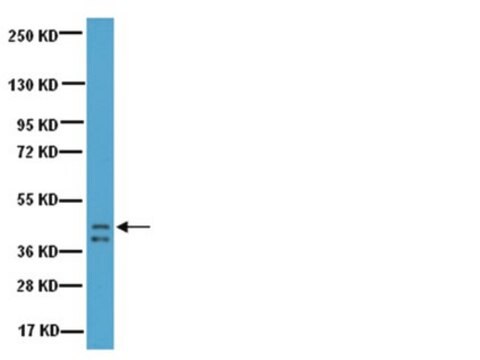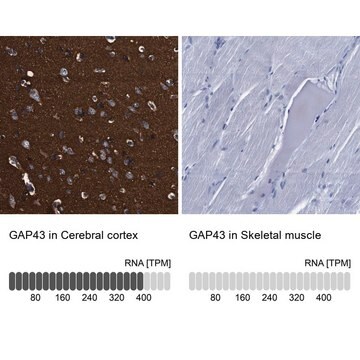G9264
Monoclonal Anti-Growth Associated Protein-43 antibody produced in mouse
clone GAP-7B10, ascites fluid
Sinônimo(s):
Anti-GAP-43
About This Item
Produtos recomendados
fonte biológica
mouse
Nível de qualidade
conjugado
unconjugated
forma do anticorpo
ascites fluid
tipo de produto de anticorpo
primary antibodies
clone
GAP-7B10, monoclonal
peso molecular
antigen 46 kDa
contém
15 mM sodium azide
reatividade de espécies
hamster, human, feline, rat, chicken, snake, mouse
técnica(s)
immunohistochemistry: suitable
western blot: 1:2,000 using newborn rat brain extract
Isotipo
IgG2a
nº de adesão UniProt
Condições de expedição
dry ice
temperatura de armazenamento
−20°C
modificação pós-traducional do alvo
unmodified
Informações sobre genes
human ... GAP43(2596)
mouse ... Gap43(14432)
rat ... Gap43(29423)
Descrição geral
Especificidade
Imunogênio
Aplicação
- immunostaining of tissue sections from the prefrontal cortex and hippocampus of rat pups to recognize an epitope present on kinase C domain in the N terminal of GAP-43 protein
- immunohistochemistry at a working dilution of 1:3000 using sections from fetal and adult brains of mice
- immunofluorescence at a working dilution of 1:4000 using 8μm sections of mice brain
- western blotting using hippocampal lysates from rats
Ações bioquímicas/fisiológicas
Exoneração de responsabilidade
Não está encontrando o produto certo?
Experimente o nosso Ferramenta de seleção de produtos.
recomendado
Código de classe de armazenamento
10 - Combustible liquids
Classe de risco de água (WGK)
WGK 2
Ponto de fulgor (°F)
Not applicable
Ponto de fulgor (°C)
Not applicable
Certificados de análise (COA)
Busque Certificados de análise (COA) digitando o Número do Lote do produto. Os números de lote e remessa podem ser encontrados no rótulo de um produto após a palavra “Lot” ou “Batch”.
Já possui este produto?
Encontre a documentação dos produtos que você adquiriu recentemente na biblioteca de documentos.
Os clientes também visualizaram
Nossa equipe de cientistas tem experiência em todas as áreas de pesquisa, incluindo Life Sciences, ciência de materiais, síntese química, cromatografia, química analítica e muitas outras.
Entre em contato com a assistência técnica







